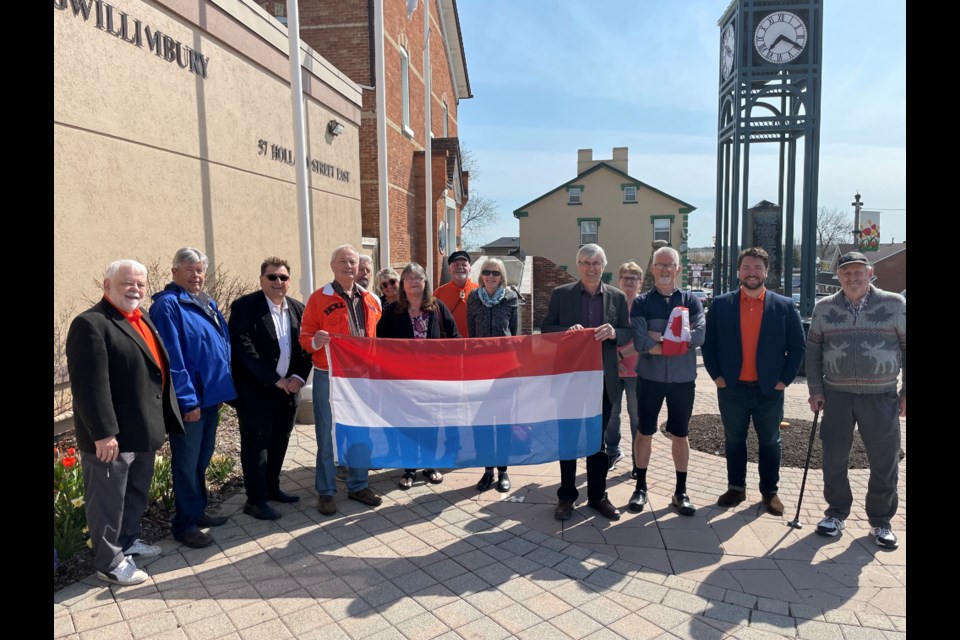This morning, in front of the Bradford West Gwillimbuty Court House, Mayor Rob Keffer, members of council, and those from the Dutch community congregated for a flag raising to signify Dutch Liberation Day.
Each year on May 5, the Dutch reflect and remember the liberation of their country from Nazi occupation during the Second World War, it follows the Remembrance of the Dead on May 4.
On May 5, 1945, Canadian general Charles Folks accepted the surrender of the German forces from German Commander-in-Chief Johannes Blaskowitz in Netherlands, forever connecting Canada and the Dutch.
In gratitude for the involvement of Canadian troops, as well as in thanks for sheltering Queen Juliana and members of the Royal family in Canada during the war years, an annual gift of 20,000 tulip bulbs is given to Ottawa to grace the nation's capital, commemorating this international friendship.
“This commemoration celebrates the significant contributions that Dutch-Canadians have made to the growth and prosperity of our province and our community giving us all a chance to pause and reflect on our values and ideals of freedom, democracy and human rights,” said Keffer.
With a strong Dutch community in Bradford West Gwillimbury, Keffer talked about the impact they have had on the town.
“Some came after the First World War and helped open up the Holland Marsh,” he said. “They’ve been a major part of the agricultural community in our municipality.”
During the Second World War, 237,300 Dutch died (2.6 per cent of the population), 120,000 Dutch Jewish people were sent to concentration camps and 104,000 of them died there, 20,000 Dutch civilians died of starvation, and 5,000 non-Jewish Dutch civilians died in concentration camps or prisons.
“As we see right now with the Ukraine, if we don’t learn from history, we keep repeating it,” said Albert Wierenga, a Dutch immigrant and Bradford resident. “It’s the young (people) who die and the old guys who send them into die, and it always concerns me that we don’t seem to learn that we can do things better and should do things better.”
As the keynote speaker, Wierenga talked about “floaters” who died during the Second World War while fighting over the ocean. They floated to shore and are buried on Schiermonnikoog at a cemetery called Vredenhoff, there are 10 Canadians and five New Zealanders buried there.
This story led into a moment of silence, like the one in Holland, that Wierenga said could be used as a chance to think about Ukraine.
“We have all these kids flying all these bombs from England to Germany, going down over the north sea and floating in,” he said. “To commemorate these people (and the others that died), on the 4th at 8 p.m. they have two minutes of silence. Nothing moves. I’d like to reflect and see what we can do because maybe as you reflect you can think of donating (to help the Ukraine).”
Another story Wierenga told was that of Mona Louise Parsons, a Nova Scotia born Canadian and member of an informal Dutch resistance network in the Netherlands. She became the only Canadian female civilian to be imprisoned by the Nazis and one of the first and few women to be tried by a Nazi military tribunal in the Netherlands.
“They don’t know how many pilots she saved, but she’s recognized by the British government,” he said. “In March of 1942 she was jailed permanently and went to a camp in Germany. She spent three years there, until she escaped and for the next 30 days, walked across Germany until she was picked up by the Nova Scotian troops. Wonderful courage, and nobody knows about her, except that they put up a statue in Wolfville for her. A person who took a stand and ran with it. That’s a wonderful thing.”



